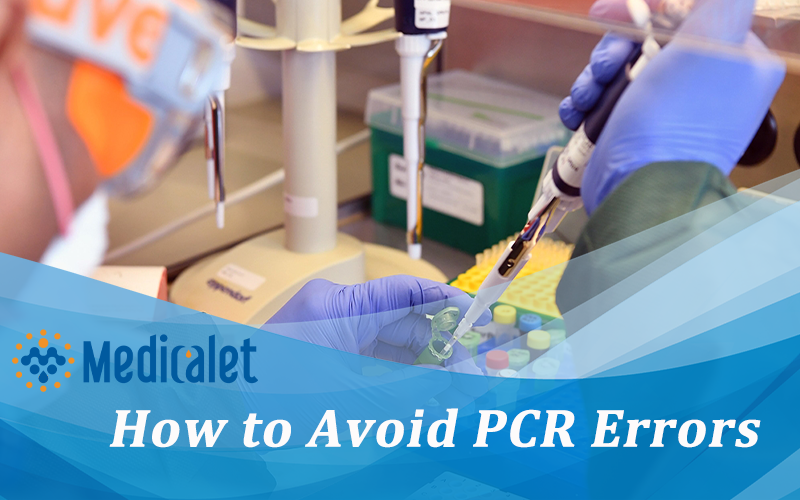
1 – Set Up a Sterile Environment
Contaminants can lead to false negatives or positives, which can make you second guess your results. These contaminants can come in many forms, from foreign DNA to chemical inhibitors that reduce the efficiency of the reaction. There are several things you can do to minimize contamination of your PCR samples and reagents:
Use sterile filter tips, which will prevent any contamination from your pipette from bleeding into your samples.
Dedicate a clean set of equipment, including racks and pipettes, solely for PCR use. This will ensure that there is minimal carryover of particles from one area of your lab to another.
Set up a reserved space for all your PCR reactions to further reduce particle contamination.
Apply ethanol, bleach, and RNaseOUT to your bench, pipettes, and racks to rinse off contaminants.
Use gloves at every step and change them often.
2 – Check template purity and concentration
Regardless of how clean your bench and equipment are, it’s still necessary to verify the purity of your samples prior to running them. Most analyzers will now measure both the concentration and purity of your DNA simultaneously. Always make sure that your 260 nm/280 nm absorbance ratio is at least 1.8. Other wavelengths between 230 nm and 320 nm can be used to detect impurities. For example, high absorbance at 230 nm suggests the presence of organic compounds or chaotropic salts, while a high reading at 320 nm indicates turbidity in your DNA sample, which can be a result of contamination.
3 – Take inventory of aliquoted PCR reagents
Freeze/thaw cycles can play havoc with your reagents if you re-use an aliquot too many times, damaging enzymes and dNTPs via recrystallization. When preparing samples, ensure that you keep track of the number of times each aliquot has been used, ideally using a LIMS, which can manage your entire inventory, including the number of times samples and reagents have been freeze/thawed.
4 – Make sure you choose the right annealing temperature
Another way errors can appear in your PCR results is using the wrong annealing temperature for a given primer set. If the reaction doesn’t work as intended, it is tempting to lower the annealing temperature to increase the chances of having a successful reaction. However, the lower the temperature, the more likely primer dimers and false positives are to appear. It is important to verify the melting curve analysis when performing qPCR, as this is a good indicator of whether the proper annealing temperature was chosen. For new primers, always make sure to determine the optimal annealing temperature prior to running samples. You can then make a table—ideally in your LIMS—of primers sets and their corresponding PCR protocol settings. Primer design software can also help with the initial design, providing proper matching annealing temperatures.
5 – Avoid overloading your wells with product
It’s tempting to run as much product as possible, especially when you’re unsure how efficient the PCR reaction is. However, running a high enough volume in an agarose gel can result in cross-contamination of the wells. Skewed results not only waste your sample but also make it more difficult to identify your samples, particularly if you overloaded samples next to control wells.
6 – Check off each reagent as it’s added to the master mix
For each PCR or qPCR reaction, there are at least 3 reagents, if not more, that need to be added to a master mix, which can then be aliquoted to any number of individual wells. Checking off reagents as they’re added is necessary to ensure that each reagent is added at its proper concentration and not left out or re-added inappropriately. The best way to do this is by scanning the barcode labels of each reagent immediately after it’s added to the mix. Using a master mix also helps minimize the need to pipette really small volumes, which can push the limits of the pipette’s accuracy.
7 – Use Proper Labels
Labeling is crucial to avoiding errors in PCR. However, the space afforded on PCR tubes and quantitative PCR (qPCR) plates is usually relatively small, making handwriting an inefficient way of identifying your samples.
8 – Match up pipette tips to sample tubes as samples are added
This may seem like a relatively obvious trick, but when dealing with rows and rows of samples, particularly if loading a 96-well plate with a single-channel pipette, it’s critical to have a system in place to give you confidence that you’ve added the correct samples into the appropriate tube. It’s easy to lose concentration after pipetting more than 5 to 10 times in a row, so looking back and matching the rows of the tips in a box to the rows of samples that need to be pipetted will guide you as each sample is added. If you’re ever unsure about making a mistake, you can look back at the exact tip placement to know if an error has occurred.
9 – Pick a comfortable place to work
Stress and fatigue play a large role in contributing to laboratory errors. It’s important to pick a comfortable workstation that will provide maximum support for your wrists, neck, back, and legs. The longer you can go without placing strain on your joints, the less chance there is of slipping up and making a pipetting error.

Years of experience in manufacturing laboratory consumables and medical products enables Medicalet to provide products of the highest quality and competitiveness. Through continuous innovation and practice, Medicalet has been recognized by more and more customers. If you are interested in Medicalet pipette tips, please feel free to contact us!
